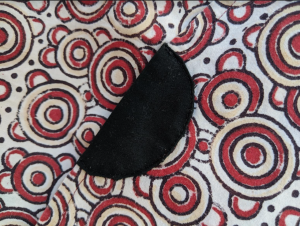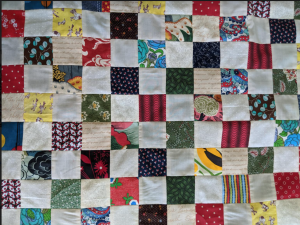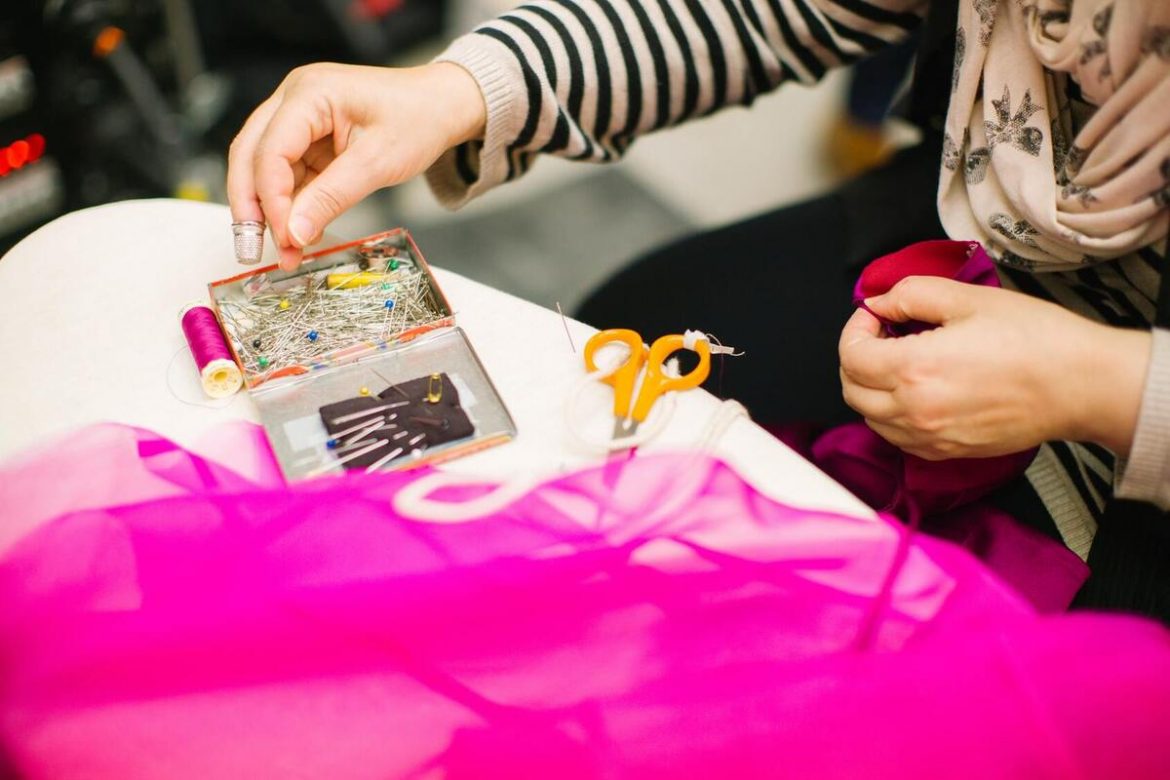
photo by Lisa Scandrette
The hem on one of my favorite skirts tore; it is made of a block print, a gift from a friend. For a while I wore it that way—the skirt is full, the tear is not large, and I would forget it was torn until I put it on again. Recently I was preparing to travel and I wanted to take this skirt along. This time, I remembered that it needed some loving attention. I decided to repair it using visible mending—a method of repair that embellishes items rather than trying to make repairs invisible. I cut out a black circle from some scrap fabric, echoing the pattern of the print, folded it over the edges of the tear and sewed it down along the edges. I love my little patch—so much so that I fingered that little patch over and over the first time I wore the skirt again, admiring its clever presence on my hemline.

photo by Lisa Scandrette
I’ve also been assembling a scrap quilt from leftover fabrics. When I was little, my mother had a number of scrap quilts that we called “nap blankets”. Rather than crawling under the covers for a nap, I would lay on top of the bed covers and my mom would cover me with a nap blanket made from bits and pieces left over from sewing clothes. So when I was outgrowing my naps, I would often lay there and search the blanket for pieces of my shirts, my sisters dresses, and favorite fabrics I recognized until rest time was declared officially over. The scrap quilt I am making holds similar memories from leftover projects—birthday banners for nephews and nieces, a costume for my daughter, Christmas gifts and thrifted scraps all reimagined into a new blanket. It’s not coming together rapidly. Rather, it builds two inch square by two inch square and then row by row until it’s big enough to cover someone I love.
An author I read recently argued that we need to become more materialistic rather than less. The words startled me to attention, opposed to what I would usually think. The author went on to explain that perhaps we need to learn to really love the things in our care—to tend them, enjoy them, mend them, pay attention to them rather than letting our attention float so quickly to new items. I’ve been contemplating that in regard to the things in my possession. I often think that the next new thing will be so satisfying and engaging, but neglect to fully enjoy and engage with the last thing I brought into my home.
During this time of COVID-19 sheltering, I have had the opportunity to dive even more deeply into fully appreciating and finding contentment in what already surrounds me—using things, creating from scraps, repairing things, living more softly on the earth. When I think of mending, patching, altering or of creating beauty from scraps or discards, I often think of Jesus. Jesus was all about making the broken whole, lifting those discarded by society, naming their value, making beauty from the most unlikely things, reimagining a more whole way of being in the world. Restoration is holy work—the work of making repairs, of restoring, of reclaiming. It’s also slow work. I love instant results and for things to come together quickly, but Jesus was never in a hurry, and transformation, both of souls and of material goods, takes time, persistence and patience. As I slowly work with my hands, I contemplate what slow work I am allowing Jesus to do in me, asking what he might be restoring, what he might be piecing together in more whole and beautiful ways. What slow work of restoration am I being invited to join in?
What is already around you that you can enjoy? What can you breathe new life into? What is the work of restoration that is yours to do?


4 comments
Thank you for this image. I am actually sewing a quilt for a wedding for a couple that together are so complicated that to symbolize their lives the patches (I hand patch) are all difference fabric (289 of them 17×17) I had to crowdsource to get the fabrics, but everyone has bits. This reflection will energize my evenings of sewing.
Maren, that sounds beautiful–what a meaningful gift to the couple! And all with hand patching, too! I’d love to see it sometime.
Lisa, this is beautiful. Thank you for sharing. I feel a little like I am on a long journey of piece by piece restoring my life, my home, my yard from the devastation of the past few years. It helps to think of it this way. Thank you for challenging my way of thinking.
Amy, may you have plenty of encouragement and companionship of your journey of restoration. May others be present to lend you their strength when the journey feels long.